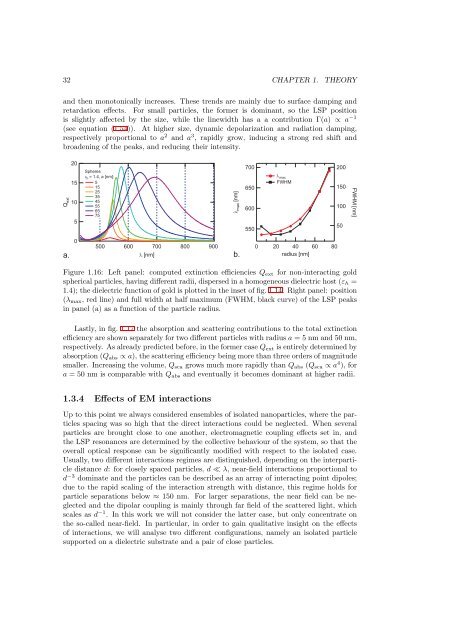Morphology and plasmonic properties of self-organized arrays of ...
Morphology and plasmonic properties of self-organized arrays of ...
Morphology and plasmonic properties of self-organized arrays of ...
Create successful ePaper yourself
Turn your PDF publications into a flip-book with our unique Google optimized e-Paper software.
32 CHAPTER 1. THEORY<strong>and</strong> then monotonically increases. These trends are mainly due to surface damping <strong>and</strong>retardation effects. For small particles, the former is dominant, so the LSP positionis slightly affected by the size, while the linewidth has a a contribution Γ(a) ∝ a −1(see equation (1.54)). At higher size, dynamic depolarization <strong>and</strong> radiation damping,respectively proportional to a 2 <strong>and</strong> a 3 , rapidly grow, inducing a strong red shift <strong>and</strong>broadening <strong>of</strong> the peaks, <strong>and</strong> reducing their intensity.Q ext2015105Spheres h = 1.4, a [nm]:515253545556575 max[nm]700650600550 maxFWHM20015010050FWHM [nm]0500 600 700 800 900a. [nm]b.020 40 60radius [nm]80Figure 1.16: Left panel: computed extinction efficiencies Q ext for non-interacting goldspherical particles, having different radii, dispersed in a homogeneous dielectric host (ε h =1.4); the dielectric function <strong>of</strong> gold is plotted in the inset <strong>of</strong> fig. 1.14. Right panel: position(λ max , red line) <strong>and</strong> full width at half maximum (FWHM, black curve) <strong>of</strong> the LSP peaksin panel (a) as a function <strong>of</strong> the particle radius.Lastly, in fig. 1.17 the absorption <strong>and</strong> scattering contributions to the total extinctionefficiency are shown separately for two different particles with radius a = 5 nm <strong>and</strong> 50 nm,respectively. As already predicted before, in the former case Q ext is entirely determined byabsorption (Q abs ∝ a), the scattering efficiency being more than three orders <strong>of</strong> magnitudesmaller. Increasing the volume, Q sca grows much more rapidly than Q abs (Q sca ∝ a 4 ), fora = 50 nm is comparable with Q abs <strong>and</strong> eventually it becomes dominant at higher radii.1.3.4 Effects <strong>of</strong> EM interactionsUp to this point we always considered ensembles <strong>of</strong> isolated nanoparticles, where the particlesspacing was so high that the direct interactions could be neglected. When severalparticles are brought close to one another, electromagnetic coupling effects set in, <strong>and</strong>the LSP resonances are determined by the collective behaviour <strong>of</strong> the system, so that theoverall optical response can be significantly modified with respect to the isolated case.Usually, two different interactions regimes are distinguished, depending on the interparticledistance d: for closely spaced particles, d ≪ λ, near-field interactions proportional tod −3 dominate <strong>and</strong> the particles can be described as an array <strong>of</strong> interacting point dipoles;due to the rapid scaling <strong>of</strong> the interaction strength with distance, this regime holds forparticle separations below ≈ 150 nm. For larger separations, the near field can be neglected<strong>and</strong> the dipolar coupling is mainly through far field <strong>of</strong> the scattered light, whichscales as d −1 . In this work we will not consider the latter case, but only concentrate onthe so-called near-field. In particular, in order to gain qualitative insight on the effects<strong>of</strong> interactions, we will analyse two different configurations, namely an isolated particlesupported on a dielectric substrate <strong>and</strong> a pair <strong>of</strong> close particles.
















